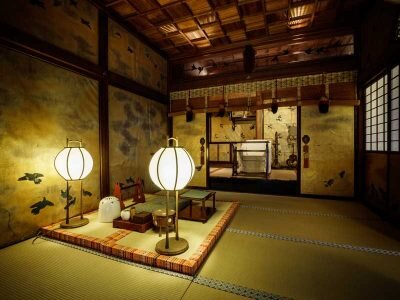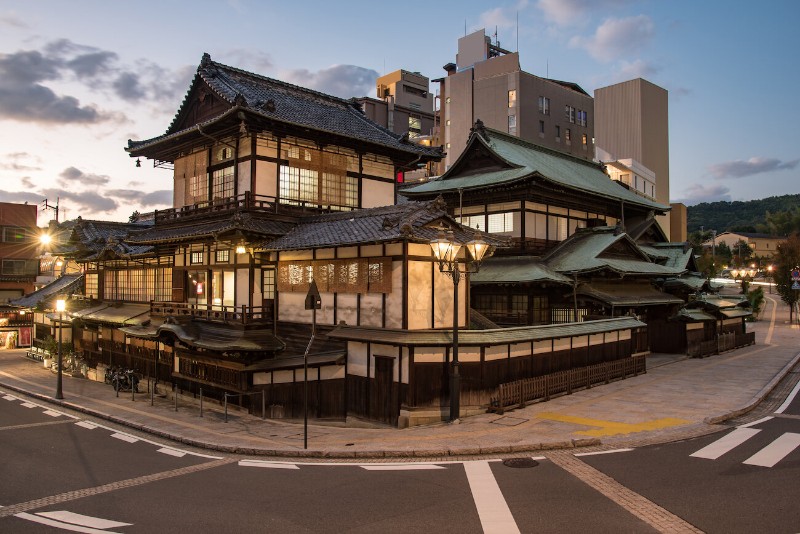Dogo Onsen Spa is one of the oldest hot spring resorts in Japan. The name Dogo Onsen appears in the Kojiki, a collection of myths about the origin of the islands forming Japan and Shinto deities. This book is considered the most ancient historical book and was written in 712. Which stories are associated with Dogo Onsen? And why should you consider a visit if you come to Japan?
History of Dogo Onsen

Several legends about this thermal station exist in the history of Japan. Here is a short version of a few of them:
The ancient legend of the white heron; a wounded white heron accidentally found the hot springs erupting from large stones. He came here every day, and after a while, his wound healed and he left in great shape. The inhabitants were surprised to see this wounded white heron leaving in such a great shape. Hence, they also decided to take a bath, and alas, they recovered from their fatigue. They also recovered from their illnesses after bathing in the hot springs.
Ever since it is said that the spa resort of Dogo was first found by this white heron. At Hojo-en square in front of Dogo Onsen station, there is a rock with the footprints of this white heron preserved to pass this legend on to future generations. We can find small depictions of the white heron on the facade of the main building of Dogo Onsen (道後温泉本館) and also on its roof.
Imperial Visits

The Shinto legend of the round stone: Shinto deity Okuni Nushi no Mikoto (worshipped at the Izumo Shrine in Shimane Prefecture) came to Dogo. He came with another deity, Sukuna Hikona no Mikoto, who was suffering from an illness. Okuni Nushi no Mikoto warmed Sukuna Hikona no Mikoto with the hot water from the springs, the latter then recovered his strength and danced on a rock. This rock is called the “Round Stone” and is worshipped north of the main building of Dogo Onsen.
The Shinto gods were not the only VIP visitors; it is said that Prince Shotoku Taishi visited the Dogo Onsen Spa in 596 and greatly appreciated the quality of the hot water. Since then, several emperors have come here to enjoy this feeling.
Start of Commercial Use
In 1635, the lord of this region, Matsudaira, founded the establishments to manage this spa, which was already famous throughout Japan. He created various baths for nobles, monks, and common women and men. This was the beginning of the public paying to enter baths in Dogo Onsen. Nowadays, there are several public baths including Dogo Onsen Honkan and ryokan with hot springs that welcome visitors.
Dogo Onsen Building Honkan (道後温泉本館), the main building of Dogo Onsen, is considered the symbol of this spa town. In 1894, the main building of Dogo Onsen Honkan (public bath) was renovated thanks to the decision by the mayor of Dogo Onsen, Isaniwa Yukiya. AIn 1994, this building was the first bathhouse to be designated as an important cultural asset.
Layout of the Spa
The Dogo Onsen Honkan is composed of 4 buildings that were built in different eras.
Main building Kami no Yu (神の湯本館棟); This 3-story building built in 1894 has the Kami no Yu bath. The 2nd and 3rd floors serve as resting rooms. The entrance to Dogo Onsen Honkan is located on the 1st floor of this building. On the wall of Kami no Yu, we can appreciate the white heron design made of porcelain from Tobe (砥部焼), a typical handicraft of Ehime prefecture.
Yushin-den (又神殿) and Tama no Yu (霊の湯); This building, constructed in 1899, is divided in 2 parts on the inside. The Yushin-den part is reserved for the imperial family: it is the only public bath that has a bathtub reserved for the imperial family. The last imperial visit was in 1952. Now we can visit with a guide (currently closed to the public due to renovations). The Tama no Yu part is open to the public so they can bathe in another kind of bathtub than Kami no Yu.
Minami building (南棟); This building, constructed in 1924, has Kami no Yu for women. The original bath is currently closed to the public due to restoration work, so Kami no Yu for women is now temporarily moved.
Main entrance (玄関棟); This building was constructed in 1924 to connect the main Kami no Yu building and the Minami building.
Local Gastronomy of Dogo Onsen
Rice garnished with sea bream (鯛釜飯) and ramen with sea bream (鯛ラーメン) are typical dishes in this area.
In the prefecture of Ehime, sea bream farming is very active. We can find several dishes using sea bream. If you want to taste sea bream at its most fresh, we recommend you to try sashimi.
There are also different kinds of local citrus fruits. In Shikoku Island, the climate is generally mild so the climate is very suitable for growing citrus fruits. Now there are up to 50 different varieties. You can taste them as fruit, juice and also in pastries.
Your Japan Tour
As seasoned Japan experts, we create perfect Japan package tours including destinations like Dogo Onsen. Check out our group tours and private tours, or contact us to start planning your unforgettable holiday to this fascinating country. Japan is full of once-in-a-lifetime experiences, culture, history, nature, and delicious food!
Access
About 20 min by streetcar from Matsuyama Station
(Matsuyama is 1h30 from Tokyo by plane)

